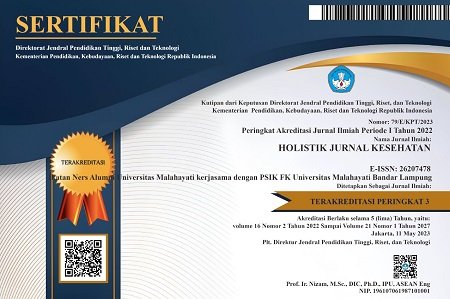Pengaruh prone position terhadap peningkatan oksigenasi pada pasien covid-19: Systematic review
Abstract
The effect of prone position for increasing oxygenation in patients with COVID-19: A systematic review
Background: Prone position is known to reduce mortality in intubated non-COVID-19 patients with moderate to severe acute respiratory distress (ARDS).
Purpose: To determine the effect of prone position for increasing oxygenation in patients with COVID-19 by a systematic review
Method: Criteria of patients with COVID-19 and pneumonia but not with severe respiratory distress (ARDS) increasing oxygen saturation, preventing the use of HFNC breathing apparatus, and preventing the need for intubation. Search systematically from 5 database s medical (PubMed, Proquest, Embase, Medline, Cinhal ) and 1 manual (Google) performed until 12 October 2020, from 5 databases and 1 manual (Google) found 5 articles that met the inclusion criteria, and 122 patients were included for the final analysis.
Results: The severity of disease and the need for intubation decreased by 65,6% in patients. The prone position to increase oxygenation, prevent disease severity, intubation / ICU, and mechanical ventilation to see the effect of the prone position on increasing oxygen saturation.
Conclusion: Prone position indicates increased oxygenation of patients with respiratory disease related to COVID-19. The severity of the disease and the need for intubation decreased by 65.5% in the patients. For this reason, the need for the prone position in COVID-19 patients with pneumonia before falling into ARDS, the provision of the prone position was done randomly
Keywords: Prone Position; Patient; COVID-19; Oxygenation
Pendahuluan: Prone posisi diketahui dapat menurunkan angka kematian pada pasien non-COVID-19 yang diintubasi dengan gangguan pernapasan akut sedang sampai berat (ARDS). Namun literature yang meneliti tentang efek posisi prone pada pasien COVID-19 masih kurang.
Tujuan: Untuk mengetahui pengaruh posisi tengkurap terhadap peningkatan oksigenasi pada pasien COVID-19 dengan tinjauan sistematis
Metode : Kriteria pasien COVID-19 dengan pneumonia tetapi tidak yang mengalami gangguan pernafasan berat (ARDS) sehingga meningkatkan satursi oksigenasi, mencegah penggunaan alat bantu napas HFNC, dan mencegah kebutuhan intubasi. Pencarian sistematis dari 5 databases medis (PubMed, Proquest, Embase, Medline, Cinhal) dan 1 manual (Geogle) dilakukan hingga 12 oktober 2020, dari 5 databases dan 1 manual (Geogle) ditemukan 5 artikel yang memenuhi kriteria inklusi, dan 122 pasien dilibatkan untuk analisis akhir.
Hasil: Sebagian besar pasien berusia diatas 50 tahun dengan dominasi jenis kelamin laki-laki (67%), peningkatan saturasi oksigenasi 81/122 (66,4%), respiratori rate < 30 x/menit (60%), tidak diintubasi 78/119 (65,5%), dan penurunan jumlah kematian 77/85 (90,6%) dari penelitian. Komplikasi yang berhubungan dengan pemberian posisi prone yang dilaporkan dalam study literature 9% discomfort, 4% worsening oxygenation, 2% coughing, 5 deaths (9%) [1], 42% backpain, 17% tolerated <1 h, 17% required intubation within 72 h, Tetapi menurut study literature Damarla (2020) dan Schifino G, at al (2020) tidak ditemukan komplikasi intubasi dan kematian. Pemberian prone posisi untuk peningkatan oksigenasi, mencegah derajat keparahan penyakit, tindakan intubasi/ICU dan ventilasi mekanik untuk melihat efek prone posisi terhadap peningkatan saturasi oksigen
Simpulan: posisi prone menunjukkan peningkatan oksigenasi pasien penyakit pernapasan terkait COVID-19. Derajat keparahan penyakit dan kebutuhan intubasi menurun 65,5% pada pasien. Untuk itu perlunya posisi prone pada pasien COVI-19 dengan pneumonia sebelum jatuh ke acute respiratory distress (ARDS), pemberian posisi prone ini dilakukan secara randomisasi.
Keywords
References
Anand, S., Baishya, M., Singh, A., & Khanna, P. (2020). Effect of awake prone positioning in COVID-19 patients-A systematic.
Coppo, A., Bellani, G., Winterton, D., Di Pierro, M., Soria, A., Faverio, P., & Foti, G. (2020). Feasibility and physiological effects of prone positioning in non-intubated patients with acute respiratory failure due to COVID-19 (PRON-COVID): a prospective cohort study. The Lancet Respiratory Medicine, 8(8), 765-774.
Damarla, M., Zaeh, S., Niedermeyer, S., Merck, S., Niranjan-Azadi, A., Broderick, B., & Punjabi, N. (2020). Prone positioning of nonintubated patients with COVID-19. American journal of
Despres, C., Brunin, Y., Berthier, F., Pili-Floury, S., & Besch, G. (2020). Prone positioning combined with high-flow nasal or conventional oxygen therapy in severe Covid-19 patients. Critical Care, 24, 1-2.
Elharrar, X., Trigui, Y., Dols, A. M., Touchon, F., Martinez, S., Prud’homme, E., & Papazian, L. (2020). Use of prone positioning in nonintubated patients with COVID-19 and hypoxemic acute respiratory failure. Jama, 323(22), 2336-2338.
Ghelichkhani, P., & Esmaeili, M. (2020). Prone position in management of COVID-19 patients; a commentary. Archives of academic emergency medicine, 8(1).
Golestani-Eraghi, M., & Mahmoodpoor, A. (2020). Early application of prone position for management of Covid-19 patients. Journal of clinical anesthesia, 66, 109917.
Goligher, E. C., Hodgson, C. L., Adhikari, N. K., Meade, M. O., Wunsch, H., Uleryk, E., & Fan, E. (2017). Lung recruitment maneuvers for adult patients with acute respiratory distress syndrome. A systematic review and meta-analysis. Annals of the American Thoracic Society, 14(Supplement 4), S304-S311
Khan, M. A. (2020). Implementation Of Telemedicine System To Improve And Expand Covid-19 Screening And Evaluation: A Reflection On Action Research Approach And The Management Of The Possible Spread Of The Pandemic. American Journal Of Health, Medicine And Nursing Practice, 5(1), 12-24.
Munshi, L., Fralick, M., & Fan, E. (2020). Prone positioning in non-intubated patients with COVID-19: raising the bar. The Lancet Respiratory Medicine, 8(8), 744-745.
Ng, Z., Tay, W. C., & Ho, C. H. B. (2020). Awake prone positioning for non-intubated oxygen dependent COVID-19 pneumonia patients. European Respiratory Journal, 56(1).
Reddy, M. P., Subramaniam, A., Lim, Z. J., Zubarev, A., Afroz, A., Billah, B., & Shekar, K. (2020). Prone Positioning Of Non-Intubated Patients With COVID-19-A Systematic Review And Meta-Analysis. medRxiv.
Sarma, A., & Calfee, C. S. (2020). Prone positioning in awake, Nonintubated patients with COVID-19: necessity is the mother of invention. JAMA Internal Medicine, 180(11), 1539-1540.
Sartini, C., Tresoldi, M., Scarpellini, P., Tettamanti, A., Carcò, F., Landoni, G., & Zangrillo, A. (2020). Respiratory Parameters In Patients With COVID-19 After Using Noninvasive Ventilation In The Prone Position Outside The Intensive Care Unit. Jama, 323(22), 2338-2340.
Schifino, G., De Grauw, A. J., Daniele, F., Comellini, V., Fasano, L., & Pisani, L. (2020). Effects Of Prone And Lateral Position In Non-Intubated Patients With 2019 Novel Coronavirus (COVID-19) Pneumonia. Pulmonology.
Slessarev, M., Cheng, J., Ondrejicka, M., & Arntfield, R. (2020). Patient Self-Proning With High-Flow Nasal Cannula Improves Oxygenation In COVID-19 Pneumonia. Canadian Journal Of Anesthesia/Journal Canadien D'anesthésie, 67(9), 1288-1290.
Sztajnbok, J., Maselli-Schoueri, J. H., de Resende Brasil, L. M. C., de Sousa, L. F., Cordeiro, C. M., Borges, L. M. S., & Malaque, C. M. S. A. (2020). Prone positioning to improve oxygenation and relieve respiratory symptoms in awake, spontaneously breathing non-intubated patients with COVID-19 pneumonia. Respiratory medicine case reports, 30, 101096.
Taboada, M., González, M., Álvarez, A., González, I., García, J., Eiras, M., & Alvarez, J. (2020). Effectiveness Of Prone Positioning In Non-Intubated ICU Patients With Moderate To Severe ARDS By COVID-19. Anesthesia And Analgesia.
Thompson, A. E., Ranard, B. L., Wei, Y., & Jelic, S. (2020). Prone Positioning In Awake, Nonintubated Patients With COVID-19 Hypoxemic Respiratory Failure. JAMA Internal Medicine, 180(11), 1537-1539.
Xu, Q., Wang, T., Qin, X., Jie, Y., Zha, L., & Lu, W. (2020). Early Awake Prone Position Combined With High-Flow Nasal Oxygen Therapy In Severe COVID-19: A Case Series. Critical Care, 24(1), 1-3.
DOI: https://doi.org/10.33024/hjk.v15i2.4894
Refbacks
- There are currently no refbacks.
Copyright (c) 2021 Holistik Jurnal Kesehatan

This work is licensed under a Creative Commons Attribution-NonCommercial 4.0 International License.














